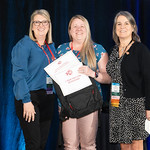| 7:00 AM – 7:50 AM |
STN Annual Member Meeting & Breakfast
Maria McMahon, MSN, RN, PNP-PC/AC, TCRN, STN President 2020 & 2021
|
| 8:00 AM – 8:45 AM |
Presidents' Address
Presenters: Amy Krichten, MSN, RN, CEN, TCRN, STN President-Elect
Maria McMahon, MSN, RN, PNP-PC/AC, TCRN, STN President 2020 & 2021 |
| 8:45 AM – 9:45 AM |
Keynote Address: The Art of Making Connections
Minna Hong
Moderator: Amy Krichten, MSN, RN, CEN, TCRN |
| |
 The impacts of trauma survivorship are vast, extending into every facet of life. Minna Hong will present her personal story of how she reclaimed her life following a catastrophic injury. She will draw on her personal experiences to discuss the importance of clinicians’ interpersonal interactions with their patients using soft skills, encouraging resilience, and maintaining self-care practices while offering real world solutions. The impacts of trauma survivorship are vast, extending into every facet of life. Minna Hong will present her personal story of how she reclaimed her life following a catastrophic injury. She will draw on her personal experiences to discuss the importance of clinicians’ interpersonal interactions with their patients using soft skills, encouraging resilience, and maintaining self-care practices while offering real world solutions.
Minna uses her artistic talent to create ceramic tokens from leftover potter’s clay to spread a special message of connectivity.
|
| 9:30 AM – 3:30 PM |
Blood Drive
The Red Cross is experiencing the worst blood shortage in over a decade. On Thursday, March 31, STN is partnering with the American Red Cross to host a blood drive at TraumaCon 2022. We encourage you to register in advance at a time that will work for you.
|
| 9:45 AM – 10:00 AM |
Refreshment Break in Exhibit Hall |
| 10:00 AM – 11:00 AM |
Concurrent Sessions Round 1
|
| |
Early Recognition and Rescue of the Injured Patient
Presenter: Ellen Harvey, DNP, RN, ACNS-BC, CCRN, TCRN, FCCM
Injured patients are at high-risk for clinical decline. Trauma nurses play the essential role in early recognition of often-subtle warning signs to reduce the poor outcomes associated with failure to rescue and unplanned ICU admissions in injured patients. Using an interactive case study approach, the presentation provides a foundational review of the major reasons for, early warning signs of and specific strategies to reduce the incidence of failure to rescue in the trauma population. Learning Objectives:
- Discuss risk factors for failure to rescue and unplanned ICU admissions in the injured patient.
- Identify ten major early warning signs suggesting clinical decline in the injured patient.
- Describe essential strategies to use in practice to prevent failure to rescue of the injured patient.
|
| |
Can you Effectively Utilize What You Don't Know? Trauma Registry for Data Users
Presenter: Jane McCormack, BSN
Moderator: Kathleen Martin, MSN, RN
Trauma Registry has evolved from simple spreadsheets to complex, integrated software systems. Registry data abstraction and submission requires a high-level unique skill set, which the Trauma Program Manager (TPM) and other data users may lack. Utilization is enhanced by understanding the trauma registry elements and processes. This discussion will help guide you through the formidable task of learning the basics of trauma registry so that effective data utilization and supervision can occur. Learning Objectives:
- Define critical terms relating to trauma registry; including mapping, submission, concurrent collection, data dictionaries and data validation.
- Utilize a SWOT analysis to assess individual trauma center registry functioning.
- Identify key resources vital to enhance trauma registry performance"
|
| |
Hip Fracture Performance Improvement: A Multidisciplinary Approach From Zero to Beyond Goal
Presenter: Melissa Harte, DNP, MSHA, RN, TCRN
Moderator: Betsy Seislove, MSN, RN
EBP indicates that repair of isolated hip fractures should be done within 24 hours from the time of arrival to the ED. The evidence indicates improved overall patient outcomes compared to those where operative intervention was delayed. A multi-disciplinary team was formed aimed toward reviewing processes, removing barriers, analyzing data, and case reviews. The team identified multiple best practices and moved the needle for “to the OR in <24 hours” from 45.8% in 2018 to 91.3% in 2021. Learning Objectives:
- Discuss a multi-disciplinary approach to performance improvement for hip fracture management
- Review applicable metrics and barriers to achieving intended goals
- Share best practices in overcoming obstacles seemingly easy to remove
|
| |
A Systematic Approach to Evaluating Pediatric Patients with Injuries Concerning for Non-Accidental Trauma
Presenter: Mary Maginas, RN, BSN, MSN, CPNP
Moderator: Dina Bailey, RN
This session will present a dedicated Level II Pediatric Hospital’s experience implementing Pediatric non-accidental trauma guidelines and provide systematic and detailed discussion of evidence behind the decision algorithm. Case studies will be presented, and recent literature including the American College of Surgeons TQIP Guidelines for recognition of Child Abuse, Elder Abuse and Intimate Partner Violence, with emphasis on pediatric injuries, will be reviewed. Learning Objectives:
- Participants will be able to identify injury patterns concerning for Pediatric non-accidental trauma.
- Participants will be able to explain the work-up required for Pediatric patients with injuries concerning for non-accidental trauma.
- Participants will be able to identify resources within their facility for collaboration and management of patients with non-accidental trauma."
|
| 11:10 AM – 12:10 PM |
Concurrent Sessions Round 2
|
| |
Too Hot to Handle
Presenter: Debbie Harrell, MSN, RN, NE-BC
Moderator: Yasmin Conaway, RN
Through current, evidence-based information, the trauma professional will discover proper acute care of the burn patient. Case studies will be delivered with vivid photographs and interactive slides, to highlight the role of the HCP in the initial management of a burn patient: discussion of fluid resuscitation, intubation decisions, inhalation injuries, determining burn size, and treatment interventions. Acute burn care determines both short and long-term outcomes, including survivability. Objectives:
- Identify the immediate priorities of the initial stabilization following thermal injury.
- Describe the different mechanisms of thermal injuries.
- Explore current burn treatment modalities including the wound healing process."
|
| |
Trauma Practice Management Guidelines: From Concept to Bedside
Presenters: Vicki Bennett, MSN, RN
George Kasotakis, MD, MPH, FACS, FCCM
Lisa Kodadek, MD
Moderator: Amy Koestner, MSN, RN
Development of Practice Management Guidelines (PMGs) utilizing GRADE methodology can be challenging for those with little or no prior experience. This session will review the key aspects of developing a PMG using GRADE, provide avenues for involvement in PMG Development for anyone interested, and demonstrate recently published PMGs and how they can be applied in daily practice. Learning Objectives:
- Provide an overview & the steps of GRADE methodology.
- Discuss recent PMGs & how these can be incorporated into daily practice.
- Describe how evidenced-based medicine adds value to health systems.
- Discuss barriers to standardization and implementation."
|
| |
Comprehensive Strategies for Reducing Motor Vehicle VS. Pedestrian/Cyclist Collisions
Presenter: Michael Rosenblatt, MD, MPH, MBA, FACS
Moderator: Heather Sieracki, MSN, RN, CSTR
This presentation will discuss ways in which trauma professionals can have a better understanding for improved infrastructure, redesign, and traffic flow behaviors needed to improve community safety regarding pedestrian and cyclists. Learning Objectives:
- Participants will gain knowledge of the magnitude of the problem of Motor Vehicle vs. Pedestrian/Cyclist Collisions
- Participants will gain knowledge of the comprehensive strategies available to reduce the opportunity that motor vehicles will strike pedestrians or cyclists
|
| |
Understanding Amputations in the World of Trauma: The Various Types, Indications and Issues Associated with Them
Presenter: Cynthia Blank-Reid, MSN, RN, CEN, TCRN
Amputations account for a small but devastating amount of traumatic injuries. They can occur as primary or secondary events, at the initial scene or months after the injury. Trauma nurses should understand the various types of amputations, whether it be traumatic, iatrogenic or from a complication. Case studies will be utilized to demonstrate the role nursing plays in preventing amputations and complications. Prevention programs for traumatic and iatrogenic injuries will be discussed. Learning Objectives:
- Differentiate between the different types of amputations and the pros and cons of each one.
- Discuss various patient populations that are prone to primary and secondary amputations.
- Describe the pathophysiology that occurs during the various types of amputations.
- Identify key nursing and physician assessments and interventions that can prevent secondary amputations from occurring.
- Discuss injury prevention programs to prevent primary amputations."
|
| 12:00 PM – 2:00 PM |
Lunch in Exhibit Hall
Exhibit Prize Drawing: 1:45pm
|
| 2:00 PM – 3:00 PM |
Concurrent Sessions Round 3
|
| |
The Do's and Dont's of Developing a Geriatric Protocol
Presenter: Francesca Sullivan, RN, BSN
Moderator: Cynthia Blank-Reid, MSN, RN, CEN, TCRN
The goal of this session is to help busy programs identify key criteria for early recognition of injured elderly patients rapidly. The elderly population continues to grow and they also have very active lifestyles. Identifying those that are at risk of having a serious injury is key in getting them back on the road to recovery. Developing criteria is challenging. One center will walk you though their journey on developing their Delta guideline, the setbacks and their favorable outcomes.
Geriatric trauma has become more and more of a concern nationally and globally. Trauma programs need to have the ability to identify elderly patients who are at risk for injury after a trauma. A northeast level 1 Trauma Center will discuss their journey on developing criteria to identify critical diagnoses in elderly patients. Discussions will be on the development process, over and under triage, patient throughput and the outcomes of developing a geriatric criteria.
|
| |
What Is Going On? Helping Patients Understand Their Trauma Journey
Presenter: Susan Cronn, DNP, RN
Moderator: Sean Elwell, MSN, RN, NE-BC, TCRN
Patients arrive to a whole new world when they experience trauma. Unlike many medical experiences, it is completely unexpected and mostly out of their control. For patients with complex polytrauma, the uncertainty of what to expect in treatment and care is a source of anxiety, which can hinder progress. As clinicians, how can we partner with our patients effectively? Can we build trust when plans change quickly? How do we structure our practice to consistently hold space for patients' concerns? Learning Objectives:
- Describe challenges of patient emotional response management in complex polytrauma
- Develop strategies to recognize points of entry into shared understanding and decision-making
- Examine own practice and uncover possible barriers to addressing complex polytrauma patient needs
- Synthesize new understanding of trauma patient issues
- Integrate into practice perspective in preparation for application to clinical scenarios"
|
| |
"Oh, They're Fine.": Strangulation in Domestic Violence and Sexual Assault Cases
Presenters: Ellen Kennedy, BSN, RN, SANE-A
Jess Hobbs, DO, FACEP
Strangulation is a frequently-utilized method used in traumatic assault. However, treatment of this injury is often minimized or overlooked during the medical screening exam. This is often due to lack of education and awareness of how this injury can quickly, and quietly, become fatal. This presentation will educate on strangulation, the prevalence of this act in domestic/sexual assault patients, how to medically screen and treat these patient, along with substantial long-lasting impacts. Learning Objectives:
- Define strangulation and the sub-categories of the act.
- List signs and symptoms of strangulation, both short-term and long-term.
- Describe treatment and care options for victims of strangulation.
|
| |
Why Are Trauma Patients So Hungry?
Presenters: Darrell Hunt, MD, PhD, FACS
Kelsey Higgins, MS, RD, LD, CNSC
Jordan Rahm, BA
Moderator: Vicki Moran, PhD, RN, CNE, MPH, APHN-BC, CDE, TNS
Malnutrition and delayed tube feed initiation are contributing factors to the mortality of trauma patients; yet, procedures to deliver adequate nutrition to critically ill patients are not commonly utilized. The speaker will present Safe Start, an early enteral nutrition initiative which provides trauma patients with an easily tolerated, high-protein, fiber free option. This standardized order will prove to significantly decrease the timing to tube feed initiation. Learning Objectives:
- Investigate the prevalence of delayed tube feed initiation and malnutrition as a contributing factor to trauma patient’s mortality and hospital length of stay.
- Explore the importance of early enteral nutrition for critically ill patients.
- Learn how to create a standardized protocol to provide early enteral nutrition to critically ill patients."
|
| 3:15 PM – 4:15 PM |
Plenary Session: How Resiliency Can Defeat Vicarious Trauma
Kate Phillips, MSN, RN, CEN, SANE |
| |
This presentation will discuss what vicarious trauma is and contributing factors, along with the signs and symptoms a healthcare provider can experience. Resiliency tools that can combat effects of vicarious trauma will also be examined.
Learning Objectives:
- Learners will be able to identify vicarious trauma contributing factors, along with common signs and symptoms.
- Learners will be able to describe approaches to build resiliency."
|
| 4:15 PM |
Day 1 Closing Remarks
Dan Kiff, MN, RN |
| 4:30 PM - 7:00 PM |
Poster Session
Poster Judging & Participant Viewing (Optional CE)
Evidence-Based Practice (EBP)
- E63: Balancing Act- Finding 1:1:1: Jiliene George, lBSN, RN, TCRN, CCRN-k
- E75: Improving Trauma Triage Accuracy: Evaluating Focal Neurologic Deficits as a Predictor for Spine Injury: Kate Dellonte , MBA, BSN, RN
- E45: Improving Venous Thromboembolism (VTE) Prophylaxis in the Trauma Patient: Crystal Perry, MSN, RN, CEN, TCRN
- E79: Massive Transfusion Protocol Improvement in Level I Trauma Center: Kelly Rumsey, DNP, RN, TCRN,CEN, ACNP-BC, PNP-BC
- E74: Oh Snap! Open Fractures and The Time to IV Antibiotics: Melissa Sorensen, BSN, RN, CEN, CSTR, D-ABMDI
- E90: Utilizing Trauma Video Review to Address Performance Improvement and Patient Safety Program Pitfalls: Kate Dellonte, MBA, BSN, RN
Research
- R43: An Experimental Study to Measure the Benefits of Attending Refresher Course After Completion of ATCN Course: Alaa Sawalha, RN
- R26: Compassion Fatigue in Trauma Registry Professionals: Amanda Truelonve, RHIA, CSTR, AHIMA ICD-10-CM/PCS Trainer
- R68: Effects on Trauma Activations After Implementation of Trauma Resuscitation and Emergency Care Nurse Role: Michael Wayne Holder BSN, RN, CEN
- R42: Facilitating Transition to Practice for Acute Care Nurse Practitioners Through a Cadaver Workshop: Caroline T. Banes, DNP, APRN, ACNP-BC
- R48: Family Presence During Pediatric Trauma Resuscitation: A Review of the Literature : Maria Bautista-Durand, MSN, FNP-C, PNP
- R27: Measuring the Continuum of Trauma Bay Strain and Its Impact on Nursing Resources: Kristen M. Chreiman, MSN, RN, TCRN, CCRN-K
- R84: Molecular Adsorbent Recirculating System (MARS) Therapy for Trauma-related Acute Liver Failure: Donna Mursch, BSN, RN, CCRN
- R88: The Outreach Priority Score: A Novel Method for Objectively Focusing Trauma Center Outreach: Todd Nickoles, RN, BSN, MBA, TCRN
- R59: Prehospital Firearms-related Injury Descriptives: U.S. National Trends: Morgan K. Anderson, MPH
- R52: Prevalence and Characteristics of Patients with Marijuana Exposure at Time of Injury in Moderate/Severe TBI: Dina Elias, MSN, CCNS
- R62: Prevalence and Predicative Characteristics of Agitation in Patients with Traumatic Brain Injury in Acute Care Settings: Karen A. McQuillan,MS, RN, CNS-BC, CCRN, CNRN, TCRN, FAAN
- R82: Reduction of Opioid Utilization in Trauma: A Multimodal Approach: Karen Petersen Pugmire, APRN
- R16: To Go or Not To Go: Building a Tele-Consultation Program for the Triage of Burns in a Rural Setting: Michelle Broers, PT, DPT, CWS, FACCWS
- R25: The Use of Midline Intravenous Access to Achieve Three Years CLABSI Free in an Adult Level 1 Trauma Intensive Care Unit: Haley Strebler, MA, BSN, RN, ATC, TCRN
- R65: Yes We Can! Trauma Nurses Knowledge and Perceived Impact on Health-Related Quality of Life: Lily Silverstein BSN, RN
Sharing Your Best
- S33: Adherence to Blunt Cerebrovascular Injury Trauma Guideline: A Performance Improvement Project: Sarah A. McIntyre, MSN, CEN, TCRN
- S41: After the After Action Report: Turning Lessons Learned Into Change Following a Mass Shooting at an Urban Trauma Center: William M. Hallinan, RN, MS
- S80: All for One, One for All: Development of a Comprehensive and Cohesive Hospital System Trauma Collaborative: Alexandra K. Carpenter, MHA, BSN, RN, CPEN, TCRN
- S19: Bringing Big Sky Trauma Education to the Frontier: Overcoming Barriers Utilizing a Virtual Platform: Elizabeth McCotter, BSN, RN, TCRN
- S22: Giving Back: Utilizing Trauma Nurses to Train Inpatient Nurses for CODE Proficiency: Joseph W. Brookshire, MSN, RN, CNL
- S67: Guideline Development at a Regional Level: A Framework for Success: Kelly Rumsey, DNP, RN, TCRN,CEN, ACNP-BC, PNP-BC
- S12: Happy Hour: Trauma Patient Specific Rounding Tool Increases SBIRT Compliance and Education: Brandon Todd, RN
- S53: Hit a Bullseye with a DART Team: Caitlin T. Litchfield, BSN,RN,TCRN
- S76: Identification of Secure Places to Hide in the Emergency Department During an Internal Security Alert: Melody A. Schreiner, BS, RN, BSN
- S40: Implementing a Direct to OR Resuscitation Program: Narrowing the Scope: Katherine M. Gautreaux, MSN, RN, CEN, CPEN
- S49: Implementing a Jordanian Military and Civilian Trauma System: Eman S. Qzih, RN, MSN, RMS, TPM
- S18: Incorporating a Blood Steward into the Massive Hemorrhage Protocol: Sarah Monchar, MS, PA-C
- S14: Is It Better to Know Your Patient Care Deficiencies Now or Later?: Brenda Shaver, MBA, MSN, RN, TCRN, CEN, CSTR
- S78: It’s In the Mail! An Innovative Way to Provide SBIRT Resources to Trauma Patients: Erin Hart-Rodriguez, MSW, LCSW
- S69: Perpetual Readiness in Pediatric Interfacility Trauma Transport: Amy Waunch, MSN, FNP, CEN, TCRN
- S46: Prevalence Assessment of Hypocalcemia in Trauma Patients: Jennifer A. Heidle, BS
- S47: Prevalence of Depression and Predictive Factors within Geriatric Hip Fracture Population: Jennifer A. Heidle, BS
- S56: Resolving a PI Headache: Severe Traumatic Brain Injury (sTBI) Audit Tool: Andrew Holt, BSN, RN
- S85: Saving Time and Lives With A Blood Fridge: Rhiannon Rasmussen, MSN, RN, CNL
- S17: STOPping THE BLEED on the Streets: Teaching Hemorrhage Control at the Source of Violence: Steve Weinman, MSc, RN, CEN, TCRN, TP-C, EMT
- S44: Targeting Gun Safety: Using the ACS COT Gun Safety and Your Health Program for Preventing Firearm Related Trauma : William M. Hallinan, RN, MS
- S23: Trauma Education for Emergency Medical Services in a COVID World: Haley Strebler, MA, BSN, RN, ATC, TCRN
|
| 5:00 PM – 6:00 PM |
DEI Committee Networking
|


 The impacts of trauma survivorship are vast, extending into every facet of life. Minna Hong will present her personal story of how she reclaimed her life following a catastrophic injury. She will draw on her personal experiences to discuss the importance of clinicians’ interpersonal interactions with their patients using soft skills, encouraging resilience, and maintaining self-care practices while offering real world solutions.
The impacts of trauma survivorship are vast, extending into every facet of life. Minna Hong will present her personal story of how she reclaimed her life following a catastrophic injury. She will draw on her personal experiences to discuss the importance of clinicians’ interpersonal interactions with their patients using soft skills, encouraging resilience, and maintaining self-care practices while offering real world solutions. An Army Combat Support Hospital in Iraq for a year is compared to a Level 1 Trauma Center in the northeast. Both are the highest level of care available within a defined trauma system. The structure and capabilities are described including unique challenges of providing state of the art trauma care in austere conditions with limited resources. Trauma Registries from both were used to describe mechanisms of injury, patient volume, capabilities, procedures performed and dispositions/evacuations.
An Army Combat Support Hospital in Iraq for a year is compared to a Level 1 Trauma Center in the northeast. Both are the highest level of care available within a defined trauma system. The structure and capabilities are described including unique challenges of providing state of the art trauma care in austere conditions with limited resources. Trauma Registries from both were used to describe mechanisms of injury, patient volume, capabilities, procedures performed and dispositions/evacuations. There is a separate registration fee to attend this course.
There is a separate registration fee to attend this course. This course will feature expert speakers covering topics specific to the body of knowledge in trauma nursing across the continuum of care, from injury prevention through reintegration to home.
This course will feature expert speakers covering topics specific to the body of knowledge in trauma nursing across the continuum of care, from injury prevention through reintegration to home.  There is a separate registration fee to attend this course.
There is a separate registration fee to attend this course.


















